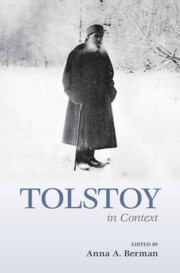Book contents
- Tolstoy in Context
- Tolstoy in Context
- Copyright page
- Contents
- Figures
- Notes on Contributors
- Preface
- Acknowledgments
- Note on Citations, Translations, and Transliterations
- Chronology
- Part I The Man
- Part II Russian Social and Political Contexts
- Chapter 5 Peasants and Folklore
- Chapter 6 The Great Reforms
- Chapter 7 Nobility and the Russian Class System
- Chapter 8 The Russian Orthodox Church
- Chapter 9 Law
- Chapter 10 Politics
- Chapter 11 War and the Military
- Chapter 12 Tolstoyans
- Chapter 13 Clothing
- Chapter 14 The “Woman Question”
- Chapter 15 The Family
- Part III Literature, the Arts, and Intellectual Life
- Part IV Science and Technology
- Part V Beyond Russia
- Part VI Tolstoy’s Afterlife
- Suggested Further Reading
- Index
Chapter 12 - Tolstoyans
from Part II - Russian Social and Political Contexts
Published online by Cambridge University Press: 05 January 2023
- Tolstoy in Context
- Tolstoy in Context
- Copyright page
- Contents
- Figures
- Notes on Contributors
- Preface
- Acknowledgments
- Note on Citations, Translations, and Transliterations
- Chronology
- Part I The Man
- Part II Russian Social and Political Contexts
- Chapter 5 Peasants and Folklore
- Chapter 6 The Great Reforms
- Chapter 7 Nobility and the Russian Class System
- Chapter 8 The Russian Orthodox Church
- Chapter 9 Law
- Chapter 10 Politics
- Chapter 11 War and the Military
- Chapter 12 Tolstoyans
- Chapter 13 Clothing
- Chapter 14 The “Woman Question”
- Chapter 15 The Family
- Part III Literature, the Arts, and Intellectual Life
- Part IV Science and Technology
- Part V Beyond Russia
- Part VI Tolstoy’s Afterlife
- Suggested Further Reading
- Index
Summary
From the 1880s onward, a vigorous movement inspired by Tolstoy’s Christian anarchist thought developed both within the Russian Empire and internationally. This chapter traces the activity of Tolstoyan communities, publishing houses, societies, and newspapers, and considers the role they played in building and maintaining international Tolstoyan networks. It considers how Tolstoy’s thought was interpreted in different national contexts as well as how and why enthusiasm for Tolstoy’s ideas emerged or revived in specific periods: it also discusses some key debates and challenges that Tolstoyans confronted, and the ways these were debated both within the movement and in interactions with those outside it. Tolstoy’s focus on following one’s own conscience meant that he strongly objected to the idea of a movement in his name. But as this chapter makes clear, while Tolstoyans were always fiercely independent-minded, the ideas and causes around which they united gave them a strong sense of being part of a collective, wherever and whenever they were active.
Keywords
- Type
- Chapter
- Information
- Tolstoy in Context , pp. 93 - 100Publisher: Cambridge University PressPrint publication year: 2022

